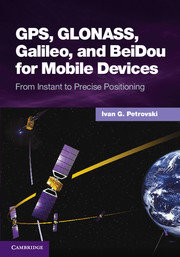Book contents
- Frontmatter
- Contents
- Foreword by Glen Gibbons
- About this book
- Acknowledgments
- List of abbreviations and acronyms
- List of definitions
- Part I GNSS: orbits, signals, and methods
- Part II From conventional to software GNSS receivers and back
- Part III Mobile positioning at present and in the future
- 8 Positioning with data link: from AGPS1 to RTK
- 9 Positioning without data link: from BGPS to PPP
- 10 Trends, opportunities, and prospects
- Part IV Testing mobile devices
- Index
- References
10 - Trends, opportunities, and prospects
from Part III - Mobile positioning at present and in the future
Published online by Cambridge University Press: 05 May 2014
- Frontmatter
- Contents
- Foreword by Glen Gibbons
- About this book
- Acknowledgments
- List of abbreviations and acronyms
- List of definitions
- Part I GNSS: orbits, signals, and methods
- Part II From conventional to software GNSS receivers and back
- Part III Mobile positioning at present and in the future
- 8 Positioning with data link: from AGPS1 to RTK
- 9 Positioning without data link: from BGPS to PPP
- 10 Trends, opportunities, and prospects
- Part IV Testing mobile devices
- Index
- References
Summary
From Cold War competition to a business model
The development of global satellite navigation was sparked by the Cold War competition between the USA and the USSR, which led to the birth of GPS and GLONASS.
The concept of satellite navigation was created in the 1960s. In 1963, Aerospace Corporation in the USA began a study on a space-based satellite navigation system. At that time, the concept of GPS had already been developed [1]. By the mid 1960s, a similar research program had started in the Soviet Union.
In a few years, both programs resulted in first satellite launches. In May 1967, the USA launched the first navigation satellite for the US Navy satellite system Timation. This satellite system provided a foundation for GPS. In November of the same year, the USSR launched the first Soviet navigation satellite, Kosmos-192, which transmitted navigation signals on 150 and 400 MHz.
In 1973, the NAVSTAR GPS program began, and in the following year the first NAVSTAR satellite was launched. The first GLONASS satellite, Kosmos-1413, was launched nine years later, in 1982. GLONASS started to be used by the international geodetic community in 1987.
- Type
- Chapter
- Information
- GPS, GLONASS, Galileo, and BeiDou for Mobile DevicesFrom Instant to Precise Positioning, pp. 274 - 290Publisher: Cambridge University PressPrint publication year: 2014



